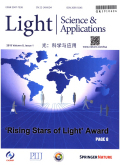- 钛学术文献服务平台 \
- 学术期刊 \
- 工业技术期刊 \
- 电工技术期刊 \
- 光:科学与应用(英文版)期刊 \
Photon-counting distributed free-space spectroscopy
Photon-counting distributed free-space spectroscopy
基本信息来源于合作网站,原文需代理用户跳转至来源网站获取
摘要:
Spectroscopy is a well-established nonintrusive tool that has played an important role in identifying and quantifying substances, from quantum descriptions to chemical and biomedical diagnostics. Challenges exist in accurate spectrum analysis in free space, which hinders us from understanding the composition of multiple gases and the chemical processes in the atmosphere. A photon-counting distributed free-space spectroscopy is proposed and demonstrated using lidar technique, incorporating a comb-referenced frequency-scanning laser and a superconducting nanowire single-photon detector. It is suitable for remote spectrum analysis with a range resolution over a wide band. As an example, a continuous field experiment is carried out over 72 h to obtain the spectra of carbon dioxide (CO2) and semi-heavy water (HDO, isotopic water vapor) in 6 km, with a range resolution of 60 m and a time resolution of 10 min. Compared to the methods that obtain only column-integrated spectra over kilometer-scale, the range resolution is improved by 2–3 orders of magnitude in this work. The CO2 and HDO concentrations are retrieved from the spectra acquired with uncertainties as low as ±1.2%and ±14.3%, respectively. This method holds much promise for increasing knowledge of atmospheric environment and chemistry researches, especially in terms of the evolution of complex molecular spectra in open areas.

推荐文章
Space多用户终端服务通讯机制的研究
Space终端服务
多用户
有效实施Free talk 学生远离哑巴英语
Free talk
哑巴英语
教学
Libera Photon在合肥光源同步光位置测量系统中的应用
同步光位置
Libera Photon
时钟分配器
对数比处理技术
在Space操作系统上运行DirectX的研究
Space
Windows
SpaceServer
DirectX
互操作
游戏
内容分析
关键词云
关键词热度
相关文献总数
(/次)
(/年)
文献信息
| 篇名 | Photon-counting distributed free-space spectroscopy | ||
| 来源期刊 | 光:科学与应用(英文版) | 学科 | |
| 关键词 | |||
| 年,卷(期) | 2021,(11) | 所属期刊栏目 | Articles |
| 研究方向 | 页码范围 | 2207-2216 | |
| 页数 | 10页 | 分类号 | |
| 字数 | 语种 | 英文 | |
| DOI | |||
五维指标
引文网络
引文网络
二级参考文献 (0)
共引文献 (0)
参考文献 (0)
节点文献
引证文献 (0)
同被引文献 (0)
二级引证文献 (0)
2021(0)
- 参考文献(0)
- 二级参考文献(0)
- 引证文献(0)
- 二级引证文献(0)
引文网络交叉学科
相关学者/机构
期刊影响力
光:科学与应用(英文版)
主办单位:
中国科学院长春光学精密机械与物理研究所
出版周期:
双月刊
ISSN:
2095-5545
CN:
22-1404/O4
开本:
出版地:
吉林省长春市东南湖大路3888号
邮发代号:
创刊时间:
语种:
eng
出版文献量(篇)
762
总下载数(次)
0
总被引数(次)
112
期刊文献
相关文献
推荐文献
- 期刊分类
- 期刊(年)
- 期刊(期)
- 期刊推荐
一般工业技术
交通运输
军事科技
冶金工业
动力工程
化学工业
原子能技术
大学学报
建筑科学
无线电电子学与电信技术
机械与仪表工业
水利工程
环境科学与安全科学
电工技术
石油与天然气工业
矿业工程
自动化技术与计算机技术
航空航天
轻工业与手工业
金属学与金属工艺
光:科学与应用(英文版)2022
光:科学与应用(英文版)2021
光:科学与应用(英文版)2020
光:科学与应用(英文版)2019
光:科学与应用(英文版)2018
光:科学与应用(英文版)2017
光:科学与应用(英文版)2016
光:科学与应用(英文版)2021年第9期
光:科学与应用(英文版)2021年第8期
光:科学与应用(英文版)2021年第7期
光:科学与应用(英文版)2021年第6期
光:科学与应用(英文版)2021年第5期
光:科学与应用(英文版)2021年第4期
光:科学与应用(英文版)2021年第3期
光:科学与应用(英文版)2021年第2期
光:科学与应用(英文版)2021年第12期
光:科学与应用(英文版)2021年第11期
光:科学与应用(英文版)2021年第10期
光:科学与应用(英文版)2021年第1期

 免费查重
免费查重










